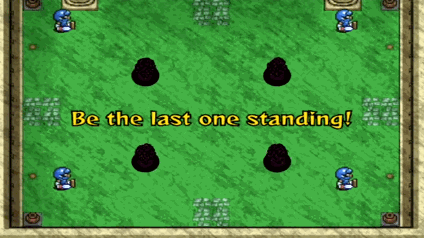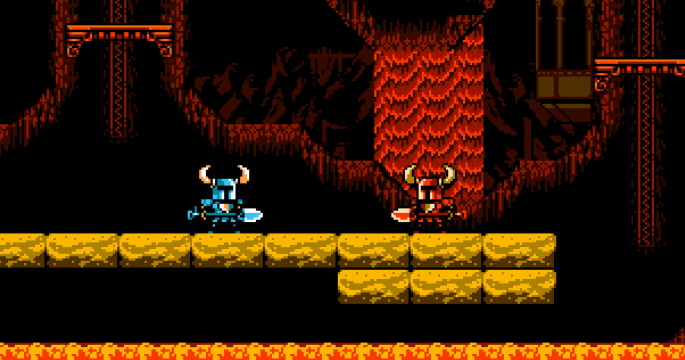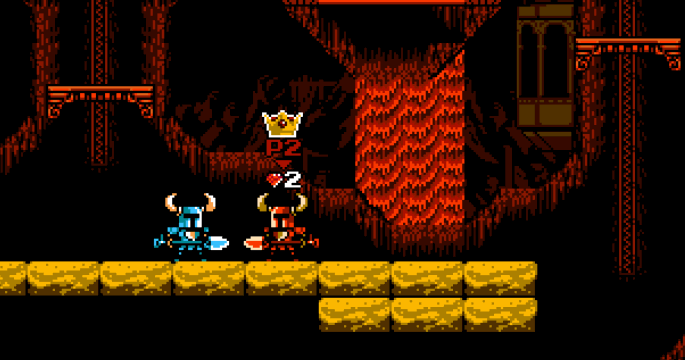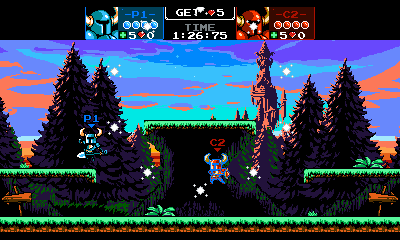Welcome, Mode Masters! We’re here to talk about the new ways to play we designed for our thrilling new multiplayer extravaganza, Shovel Knight Showdown, as well as a little tale about each mode’s inclusion. Hopefully, our yarn-spinning will give you a taste of what we think is exciting in the game, while simultaneously giving you an insider look into how we flesh out a game experience.
Crafting Multiplayer Modes
Our goal with Shovel Knight Showdown was to create a 4 player versus game that had the simplicity of games we grew up loving, but added a bit more depth and complexity in choice spots. It was first inspired by games that had multiplayer modes that maybe didn’t feel like the main feature of the game:
Just like Shovel Knight Showdown would, these games created a multiplayer experience out of the single-player mechanics. Even though they were labelled as ‘extras’ or ‘minigames’, they felt like the most fun components of the game! We wanted to recreate the joy of these experiences, while making the game feel like a centerpiece.
Combat Worthy of a Showdown
We knew that at some level, Showdown would ultimately be a game about battling each other. Because Shovel Knight emphasizes platforming, we assumed that pure fighting wouldn’t be the main mode, but if you’re playing a game featuring 4 players with attack capabilities… you typically want some kind of mode where you can solely focus on combat. Ultimately, we needed to make sure the combat was an engaging and fun experience on its own. Shovel Knight’s platforming gameplay had a lot of combat already, so we started there.
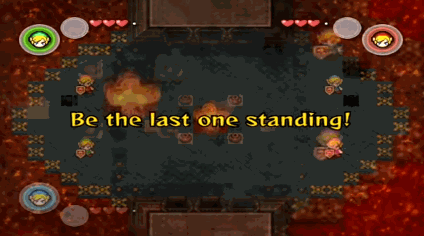
As we often do, we’ll analyze other game designs or replay our favorites for inspiration. We liked the simplicity of indie battlers like Samurai Gunn or Towerfall, but we thought it would fit a Shovel Knight duel better to last more than a single hit, as our boss battles typically do. But.. we did really enjoy the “last man standing” nature of those battles! We felt that The Legend of Zelda: Four Swords Adventures met the right combat balance: the battles felt like a good back and forth, with four health hearts and strategy evolving both aggression and evasion.
With those games fresh in our minds, we set to work prototyping! We gave each player 4 bubbles of damage, like Zelda. We blocked out a playable Black Knight that would have moves similar to but not identical to Shovel Knight, to test the mechanics with multiple character types. We initially tried to augment the basic combat added complexity with a dashing maneuver that required a lot of navigational skill to use:
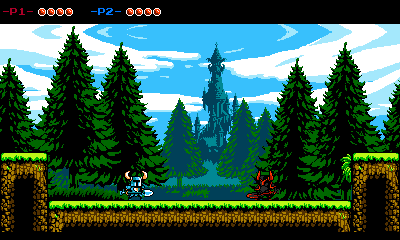
Hold attack to charge your dash, the release to use it!... this was deemed too complicated.
…but it immediately felt too crazy and far away from playing good ol’ Shovel Knight. We realized we couldn’t stray too far from the formula. We next tried battling with the characters’ original core move set with no changes at all!
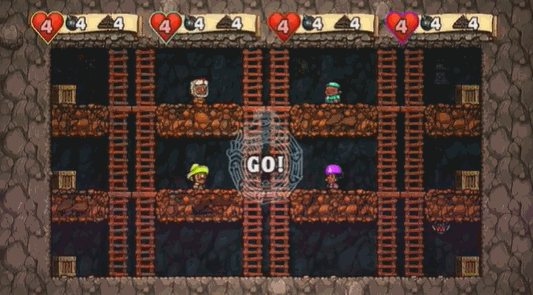
We found that we liked gameplay that closely matched classic Shovel Knight- after all, his basic mobility set was what we were comfortable with! Spelunky’s Battle mode takes this “exact same character mechanics” route to great success, but we found Shovel Knight ran into problems because there was just no way for players to escape each other’s attacks. A player might get trapped and need an escape, or there weren’t enough options to avoid a hit. As we feared, the gameplay ended up being too simple and predictable.
Because evading was too complicated and classic gameplay was too simple, we split the difference in our final design. By pressing the Parry button, any incoming attack will be repelled and you opponent will be knocked back! Powerful! However, if you miss the timing, you will be stuck in a parry position for a little while- a very clear drawback. Every character has this same parry maneuver, so it’s reliable to use for anyone. The parry worked great to get aggressive players away from you!
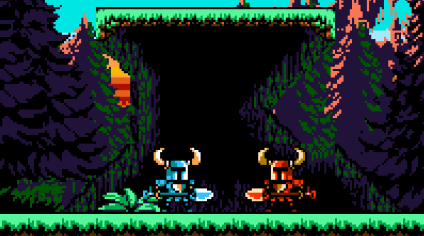
With a simple health system where all attacks did the same amount of damage and a core set of understandable mechanics, we had cracked the code of 1v1 Shovel Knight combat! This solid foundation enabled us to design characters and stages that could vary wildly! With gameplay design that rides the line between platform game and fighting game, we hoped Showdown would stand tall among the other great multiplayer games out there.
Showdown Mode

For Showdown, the most basic of multiplayer modes, We created a “Stock” option. The dramatic tension of battling over lives is as old as video games- and stock battles made health pickups even more critical!
With our Showdown Mode designed, we had another solid base for our gameplay loop. But Shovel Knight Showdown is supposed to be a game that intermingles fighting and platforming in a truly interesting way, and our flagship mode should represent that! We began to develop another mode where the interplay between the platforming and combat created a new channel of depth. This mode came to be known as Treasure Clash!
Treasure Clash Mode
We really like Super Mario Bros. battle mode. It’s so simple, yet so fun! Jumping on each other’s heads is cool, but the best part about Mario Bros. is how it incorporates platforming too. You’re bumping into each other fighting over coins while also running around trying to avoid enemies and get coins from other places. It’s a nice push and pull! But even though we’ve gotten so much joy out of this mode, it’s not exactly the kind of game that you can play for hours on end.
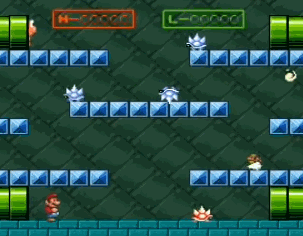
We thought our main mode could be something that takes this idea of battling and platforming to collect a resource. The theme of collecting treasure baubles is so core to Shovel Knight, it felt correct and made a ton of thematic sense too.
We figured one gem would drop from a player if they died. If they landed on the ground, we added a slight delay to them dropping the gem so other players would be encouraged to fight over the body. For gems spawning, we created a big swirl to draw attention to them- the game would then be more about how do I platform to the gem rather than paying attention to it being there. And we could play around with the logic to how they spawned a bit, to increase the tension of each battle.
From there, we could create a gem bubble that was more of a ‘fight’ to collect or having two gems spawn at once, creating much more of a frenzy to navigate to each one.
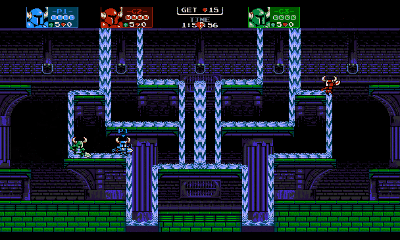
And we could create unique objects and stages that played around with how you interacted with gems.
We found this junction between combat and platforming really engaging. Not only that, but the combo mixed in ways that created new scenarios…you’d fight someone on your way to a gem to prevent them from reaching it or you’d play combat spacing games to hold ground in a gem contested area. The mobility and combat mix really freed up our character mobility design to emphasize different traits with every ability. Some characters bulkiness would make them better to collect a gem, or their quickness would get them there fast, or their ability to jump more freely would make it easier to cross gaps…there was another dimension to balance which created a much higher variety ceiling.
Mode Overload
We spent a ton of time on one last mode – a randomized roulette mode we call Chester’s Choice. Besides Chester’s Choice, we considered adding all sorts of modes: King of the Hill, Hot Potato, damage % (sumo) like Smash Bros., and more.
In the end, we wanted to keep the modes Shovel Knight-centric. We felt like the additions didn’t feel as well themed to Shovel Knight. We also wanted to avoid growing the complexity of the game as we were focused on those initial game inspirations.
More Multiplayer Features!
As we developed our multiplayer modes, we began to have additional ideas that got rolled into the mix. What would happen to break ties, or if the clock ran out, or if players wanted to adjust the experience?
Overtime
We figured a timer was important for both of our modes as we wanted battles to be over quickly, much like simpler versus games that inspired us. But how do we choose a winner timeout situations, when the clock runs out? It was pretty obvious that the player with the most remaining stock wins in Showdown and the most gems wins in Treasure Clash.
Treasure Clash’s time out got a little tricky though. For a large part of the project, we struggled over how to handle situations where the player would die right at the end and not drop their gem before the time was up, or a player would be defeated but there was no time for another player to pick up their gem and claim victory. It felt like in these ‘clincher’ situations, you need just a few more moments to extend the match!
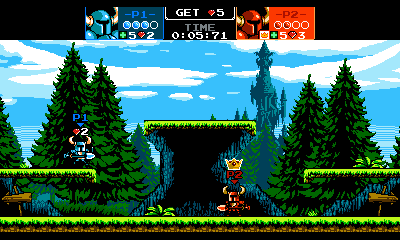
Notice how the last gem dropped switched the score to 2 to 2, changing what players are considered in the lead, thus forcing overtime.
We ended up developing ‘Overtime!’. If a gem gets dropped right at the end of the match and it would affect who takes the lead, then the game adds 5 more seconds on the clock! This solved the “unfair!” feeling we had previously, and it also created extra drama as players went after the last gem! To cap it all off, overtime can be triggered repeatedly, causing to a mad scramble as the gems go back and forth!
Sudden Death
What would happen if there was a tie at the end of the match? We would force a conclusion, of course! We’re infatuated with “sudden death” modes that rapidly cause the game to end, but what kind of version would we go with? Would it line up more with Super Smash Bros., where Sudden Death would whisk you to a whole new place? Or would something happen within the arena you were already in?
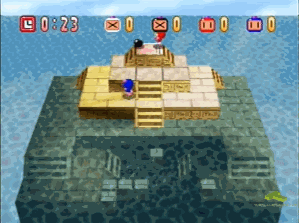
Get to the top or you’ll take a dip!
When we thought of the simplicity of the games we were looking for, the latter option seemed most appropriate. Bomberman was a big inspiration here- we loved how the arena closes in and makes players interact with one another, while keeping the flow of the battle contiguous.
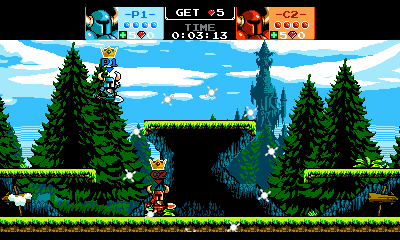
For Showdown’s sudden death, it was natural to implement lava, our deadliest hazard. We decided to remove all gems and focus Sudden Death solely on combat, even in Treasure Clash – the threat of lava would be enough to keep the interplay of combat and platforming alive. The wall of lava randomly comes from the sides or from above and below, so it’s always a surprise!
Options Galore
With our main modes all set, we started looking into other ways to complement the gameplay. We researched other game options and found a multitude of variables: teams choice, hazard settings, item frequency, chest drops, handicaps, and more. It was a bit overwhelming!
As you may have read in our Chester’s Choice article (our other main mode!), Showdown puts an emphasis on options that require less input from the player. Less complex games require less setup, and that’s a good thing!
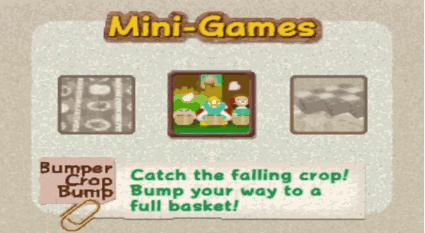
In Kirby 64, you simply pick a game and number of players, and you’re done!
We tried to keep people out of the menus, while still getting them to experience as much as possible! We added:
- Chester’s Choice, to randomize through interesting sets of options
- Team Shuffle, a way of randomizing teams for you every match
- Random hazards, a way to keep the stages feeling fresh
- Handicap, called auto-balance in Showdown, is done for you. No manual setting of handicaps required!
Streamlining options keeps players playing the game, which is where we want them to be!
That’s It for Multiplayer Modes
Once we had a great multiplayer setup, we just needed to do was add tons of content! Myriad stages, items, and characters would provide us with the depth that we craved. That development process would be a long one, but at least we know the core was working!


